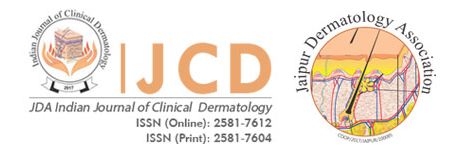CASE REPORTS
Year: 2018 I Volume: 1 I Issue: 2 I Page: 59-60
Disseminated Tufted Angioma
Mohd Mohtashim1, Syed Suhail Amin2, Mohammad Adil3, Noora Sayeed1, Annu Priya4, Tasleem Arif3
1 Senior Resident, Department of Dermatology, Jawaharlal Nehru Medical College (JNMC), Aligarh Muslim University (AMU), Aligarh, India.
2 Chairman, Department of Dermatology, Jawaharlal Nehru Medical College (JNMC), Aligarh Muslim University (AMU), Aligarh, India.
3 Assistant Professor, Department of Dermatology, Jawaharlal Nehru Medical College (JNMC), Aligarh Muslim University (AMU), Aligarh, India.
4 Junior Resident, Department of Dermatology, Jawaharlal Nehru Medical College (JNMC), Aligarh Muslim University (AMU), Aligarh, India
Corresponding Author:
Syed Suhail Amin
Professor & Chairman, Department of Dermatology
Jawaharlal Nehru Medical College (JNMC), Aligarh Muslim University (AMU), Aligarh, India.
Email: drsuhailamin@yahoo.co.in
How to cite this article:
Mohtashim M, Amin SS, Adil M, Sayeed N, Priya A, Arif T. Disseminated tufted angioma. JDA Indian Journal of Clinical Dermatology 2018;2:59-60.
Abstract:
Tufted Angioma is a benign vascular anomaly. Histopathologically it is characterized by multiple “tufts” of capillaries infiltrating the dermis in a “cannon ball” distribution.
Key words: Disseminated Tufted Angioma, vascular anomaly
Introduction:
Tufted Angioma is a rare benign cutaneous vascular proliferation of endothelium1. Histopathologically it is characterized by multiple “tufts” of capillaries infiltrating the dermis in a “cannon ball” distribution2.
Case Report:
A 10 year old male presented with multiple violaceous plaques present all over the body for the past 2 years. Initially the lesions were erythematous macules which gradually increased in size and number to involve whole body in around 6 months. On examination the plaques were violaceous in colour with tufts of hair over them[Fig.1,2]. The lesions on palpation were compressible and tender. Routine investigations like complete blood count, liver function, renal function and chest X-ray were normal. Histopathology showed lobular proliferations of blood vessels in the dermis[Fig.3,4]. Based on clinical and histopathological examination, a diagnosis of tufted angioma was made.
 |
Figure 1, 2: Violaceous plaques with tufts of hair over them |
 |
Figure 3, 2: lobular proliferations of blood vessels in the dermis[H&E;Fig3(4X),Fig4(10X)] |
Discussion:
Tufted angioma is a benign vascular anomaly that usually involves the skin and subcutaneous tissues. It was first described by Nagakawa in 19493. The exact etiology is not known but it may represent a reactive vascular tumour secondary to hormonal stimuli4. This condition usually affects children less than 1 year of age but has also been reported in pregnancy and immunosuppression. Histologically there is lobular proliferation of blood vessels which are organized in “rounded tufts” scattered in dermis. The tufts may occur in dermis or subcutaneous tissue. Males and females are affected equally by this disease. The lesion usually affects the neck, chest, shoulder and limbs5. Mostly it presents as a solitary violaceous plaque or nodule sometimes associated with hypertrichosis or hyperhidrosis. An important clinical feature is that they are tender. Malignant transformation has not been reported. One of the most severe complication of tufted angioma is consumption coagulopathy or kasabach- Meritt syndrome6.
The differential diagnosis includes infantile hemangioma, kaposiform haemangioendothelioma, venous malformations and glomovenous malformation. Spontaneous regression of lesion is usually not seen but can occur if the onset is before 6 months of age. There are multiple treatment modalities for tufted angioma. Topical and systemic steroids have been successful in few cases. One of the method used in treatment is complete surgical excision. Other treatment options are pulsed dye laser, cryosurgery, systemic interferon a therapy, soft X-ray.
References:
1. Wilson JE, Orkin M. Tufted angioma (angioblastoma). J Am Acad Dermatol 1989 .20: 214-215.
2. Osio A, Fraitag S. Arch Dermatol.2010:146(7):758-763.
3. Nakagawa K. Case report of angioblastoma of the skin. Jpn J Dermatol 1949; 92-4.
4. R.S. Padilla, M. Orkin and J. Rosai, “Acquired “tufted” angioma (progressive capillary hemangioma). A distinctive clinicopathologic entity related to lobular capillary hemangioma”. The American Journal of Dermatopathology Vol. 9 no.4 pp. 292-300, 1987.
5. R.G Aziz Khan, “complex vascular anomalies,”pediatric surgery international,vol 29, no.10 pp. 1023-1038,2013.
6. Albero FT, Betlloch I, Montero LC, Nortes IB, Martinez NL, Paz AM. Congenital Tufted Angioma. Dermatology Online Journal 2017.16:2.

